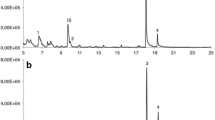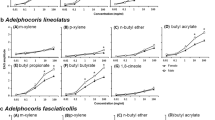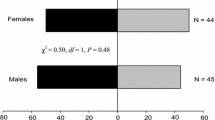Abstract
Wireworms (Coleoptera: Elateridae) are generalist insect pests that aggregate and feed on the roots of various crops, including maize. It remains unclear how they find and choose host plants. Several studies have focused on volatile organic compounds released by roots infested by wireworms, revealing the presence of 2-pentylfuran. We hypothesized that 2-pentylfuran could be a key aggregation cue that attracts wireworms towards roots colonized by conspecifics. In a series of olfactometer assays, we first investigated whether the larvae of click beetles indeed use volatile organic compounds (VOCs) as cues to locate maize roots that are already under attack by conspecifics. Surprisingly, wireworms were found to not only orient towards conspecific larvae feeding on the maize roots, but also to larvae alone. VOCs collections from plants and larvae revealed the presence of 2-pentylfuran, particularly in treatments where larvae were present. In subsequent dual-choice olfactometer assays wireworms exhibited significant attraction to 2-pentylfuran. These results imply that 2-pentylfuran is involved in wireworm aggregation behaviour, and open up opportunities for the development of an attract-and-kill strategy.




Similar content being viewed by others
References
Barsics F, Haubruge E, Verheggen FJ (2013) Wireworms’ management: an overview of the existing methods, with particular regards to Agriotes spp. (Coleoptera: Elateridae). Insects 4(1):117–152
Barsics F, Haubruge É, Francis F, Verheggen F (2014) The role of olfaction in wireworms: a review on foraging behavior and sensory apparatus. BASE 18(4):524–535
Barsics F, Delory BM, Delaplace P, Francis F, Fauconnier ML, Haubruge É, Verheggen FJ (2017) Foraging wireworms are attracted to root-produced volatile aldehydes. J Pest Sci 90(1):69–76
Cha DH, Roh GH, Hesler SP, Wallingford A, Stockton DG, Park SK, Loeb GM (2021) 2-Pentylfuran: a novel repellent of Drosophila suzukii. Pest Manag Sci 77(4):1757–1764
Chaton PF, Mauras R, Ravanel P, Meyran JC, Tissut M (2003) Taupins, comment les larves attaquent: les stratégies phytophages des larves d’Agriotes (Coléoptères, Elatéridés) sur la plantule de maïs. Phytoma 557:41–45
Cocquempot C, Martinez M, Courbon R et al (1999) Nouvelles données sur l’identification des larves de taupins (Coleoptera : Elateridae): une aide à la connaissance biologique et à la cartographie des espèces nuisibles. In: ANPP—5ème conférence internationale sur les ravageurs en agriculture. Montpellier, 7–8–9 décembre 1999, pp 477–486
Daems F, Béra F, Lorge S, Fischer C, Brostaux Y, Francis F, Lognay G, Heuskin S (2016) Impact of climatic factors on the release of E-β-caryophyllene from alginate beads. BASE. https://doi.org/10.25518/1780-4507.12781
Dicke M, Baldwin IT (2010) The evolutionary context for herbivore-induced plant volatiles: beyond the ‘cry for help.’ Trends Plant Sci 15:167–175
Dickens JC (2006) Plant volatiles moderate response to aggregation pheromone in Colorado potato beetle. J Appl Entomol 130(1):26–31
Doane JF, Lee YW, Klingler J, Westcott ND (1975) Orientation response of Ctenicera destructor and other wireworms (Coleoptera: Elateridae) to germinating grain and to carbon dioxide. Can Entomol 107(12):1233–1252
Erb M, Foresti N, Turlings TC (2010) A tritrophic signal that attracts parasitoids to host-damaged plants withstands disruption by non-host herbivores. BMC Plant Biol 10(1):247
Furlan L (1998) The biology of Agriotes ustulatus Schaller (Col., Elateridae). II. Larval development, pupation, whole cycle description and practical implications. J Appl Entomol 122:71–78
Furlan L (2004) The biology of Agriotes sordidus Illiger (Col., Elateridae). J Appl Entomol 128(9–10):696–706
Gfeller A, Laloux M, Barsics F, Kati DE, Haubruge E, du Jardin P, Verheggen FJ, Lognay G, Wathelet JP, Fauconnier ML (2013) Characterization of volatile organic compounds emitted by barley (Hordeum vulgare L.) roots and their attractiveness to wireworms. J Chem Ecol 39(8):1129–1139
Görres CM, Chesmore D (2019) Active sound production of scarab beetle larvae opens up new possibilities for species-specific pest monitoring in soils. Sci Rep 9(1):1–9
Hiltpold I, Baroni M, Toepfer S, Kuhlmann U, Turlings TC (2010) Selection of entomopathogenic nematodes for enhanced responsiveness to a volatile root signal helps to control a major root pest. J Exp Biol 213(14):2417–2423
Hiltpold I, Erb M, Robert CA, Turlings TC (2011) Systemic root signalling in a belowground, volatile-mediated tritrophic interaction. Plant Cell Environ 34(8):1267–1275
Johnson SN, Gregory PJ (2006) Chemically-mediated host-plant location and selection by root-feeding insects. Physiol Entomol 31(1):1–13
Jordan MJ, Margaria CA, Shaw PE, Goodner KL (2002) Aroma active components in aqueous kiwi fruit essence and kiwi fruit puree by GC-MS and multidimensional GC/GC-O. J Agric Food Chem 50(19):5386–5390
Kihika R, Murungi LK, Coyne D, Hassanali A, Teal PE, Torto B (2017) Parasitic nematode Meloidogyne incognita interactions with different Capsicum annum cultivars reveal the chemical constituents modulating root herbivory. Sci Rep 7(1):1–10
Kruger FS (1933) The feeding habits of wireworms with special reference to Melanotus spp. (Elateridae).
la Forgia D, Verheggen F (2019) Biological alternatives to pesticides to control wireworms (Coleoptera: Elateridae). Agri Gene 11:100080
la Forgia D, Thibord JB, Larroudé P, Francis F, Lognay G, Verheggen F (2020) Linking variety-dependent root volatile organic compounds in maize with differential infestation by wireworms. J Pest Sci. https://doi.org/10.1007/s10340-019-01190-w
la Forgia D, Bruno P, Campos-Herrera R, Turlings T, Verheggen F (2021) The lure of hidden death: development of an attract-and-kill strategy against Agriotes obscurus (Coleoptera: Elateridae) combining semiochemicals and entomopathogenic nematodes. Turk J Zool. https://doi.org/10.3906/zoo-2106-38
Loughrin JH, Potter DA, Hamilton-Kemp TR (1995) Volatile compounds induced by herbivory act as aggregation kairomones for the Japanese beetle (Popillia japonica Newman). J Chem Ecol 21(10):1457–1467
Louis J, Peiffer M, Ray S, Luthe DS, Felton GW (2013) Host-specific salivary elicitor (s) of European corn borer induce defenses in tomato and maize. New Phytol 199(1):66–73
Miles HW (1945) Wireworms and food production. Nature 155(3927):136–138
Parè PW, Farag MA, Krishnamachari V, Zhang HM, Ryu CM, Kloepper JW (2005) Elicitors and priming agents initiate plant defense responses. Photosynth Res 85:149–159
Parker WE, Howard JJ (2001) The biology and management of wireworms (Agriotes spp.) on potato with particular reference to the UK. Agric For Entomol 3(2):85–98
Pic M, Pierre E, Martinez M et al (2008) Les taupins du genre Agriotes démasqués par leurs empreintes génétiques. In: AFPP—8ème conférence internationale sur les ravageurs en agriculture. Montpellier 22–23 octobre 2008, pp 23–32
Rasmann S, Erwin AC, Halitschke R, Agrawal AA (2011) Direct and indirect root defences of milkweed (Asclepias syriaca): trophic cascades, trade-offs and novel methods for studying subterranean herbivory. J Ecol 99(1):16–25
Reinecke A, Müller F, Hilker M (2008) Attractiveness of CO2 released by root respiration fades on the background of root exudates. Basic Appl Ecol 9:568–576
Robert CA, Erb M, Duployer M, Zwahlen C, Doyen GR, Turlings TC (2012) Herbivore-induced plant volatiles mediate host selection by a root herbivore. New Phytol 194(4):1061–1069
Saussure S, Plantegenest M, Thibord JB, Larroudé P, Poggi S (2015) Management of wireworm damage in maize fields using new, landscape-scale strategies. Agron Sustain Dev 35(2):793–802
Schenkel D, Lemfack MC, Piechulla B, Splivallo R (2015) A meta-analysis approach for assessing the diversity and specificity of belowground root and microbial volatiles. Front Plant Sci 6:707
Taupin P (2007) Dossier taupin. Culture par culture. Une lutte de longue haleine. Perspect Agricol 339:27–31
Traugott M, Schallhart N, Kaufmann R, Juen A (2008) The feeding ecology of elaterid larvae in central European arable land: new perspectives based on naturally occurring stable isotopes. Soil Biol Biochem 40:342–349
Turlings TC, Tumlinson JH, Lewis WJ (1990) Exploitation of herbivore-induced plant odors by host-seeking parasitic wasps. Science 250(4985):1251–1253
Vernon RS (2005) Aggregation and mortality of Agriotes obscurus (Coleoptera: Elateridae) at insecticide-treated trap crops of wheat. J Econ Entomol 98(6):1999–2005
Vernon RS, Van Herk WG, Clodius M, Harding C (2009) Wireworm management I: stand protection versus wireworm mortality with wheat seed treatments. J Econ Entomol 102(6):2126–2136
Weissteiner S, Huetteroth W, Kollmann M, Weißbecker B, Romani R, Schachtner J, Schütz S (2012) Cockchafer larvae smell host root scents in soil. PLoS ONE 7(10).
Wenke K, Kai M, Piechulla B (2010) Belowground volatiles facilitate interactions between plant roots and soil organisms. Planta 231:499–506
Zou C, Li Z, Yu D (2010) Bacillus megaterium strain XTBG34 promotes plant growth by producing 2-pentylfuran. J Microbiol 48(4):460
Acknowledgements
The present paper is dedicated to the memory of Rhoxane Schelkens, who took an active role in the laboratory experiments, but who could not read the final version of this manuscript. D. la Forgia was supported by a Ph.D. grant from the Coordinated Integrated Pest Management in Europe (C-IPM), project ElatPro. The authors also thank Dr. Giselher Grabenweger (Agroscope) and Dr. Jörn Lehmhus (JKI) for providing wireworms;and Prof. Georges C. Lognay (Department of Functional and Evolutionary Entomology, GxABT—University of Liège) and Mickaël Gaillard for their scientific support to this study.
Author information
Authors and Affiliations
Contributions
DLF, FV, TCJT designed the experiments, DLF carried out the experiments, CM contributed to the chemical analysis and data interpretation, DLF, FV, TCJT wrote the manuscript. All authors read and approved the manuscript.
Corresponding author
Ethics declarations
Conflict of interest
The authors declare that there is no conflict of interest.
Additional information
Handling Editor: Todd Kabaluk.
Publisher's Note
Springer Nature remains neutral with regard to jurisdictional claims in published maps and institutional affiliations.
Rights and permissions
Springer Nature or its licensor (e.g. a society or other partner) holds exclusive rights to this article under a publishing agreement with the author(s) or other rightsholder(s); author self-archiving of the accepted manuscript version of this article is solely governed by the terms of such publishing agreement and applicable law.
About this article
Cite this article
la Forgia, D., Martin, C., Turlings, T.C.J. et al. 2-Pentylfuran: an aggregation attractant for wireworms. Arthropod-Plant Interactions 17, 465–472 (2023). https://doi.org/10.1007/s11829-023-09958-9
Received:
Accepted:
Published:
Issue Date:
DOI: https://doi.org/10.1007/s11829-023-09958-9




